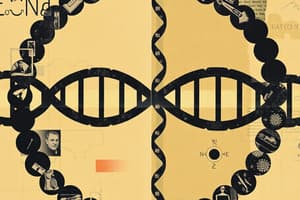Podcast
Questions and Answers
What are the main functions of DNA?
What are the main functions of DNA?
To store and transmit genetic information to cells.
Identify the types of locations of covalent bonds and hydrogen bonds in a DNA molecule.
Identify the types of locations of covalent bonds and hydrogen bonds in a DNA molecule.
Covalent bonds are between each individual nucleotide; hydrogen bonds are between the nitrogen bases.
List the base pairing rules.
List the base pairing rules.
Cytosine pairs with Guanine; Adenine pairs with Thymine.
What roles do enzymes play in DNA replication?
What roles do enzymes play in DNA replication?
How would a deoxyribose sugar-phosphate backbone of nucleotide chains look if purines paired only with purines and pyrimidines paired only with pyrimidines?
How would a deoxyribose sugar-phosphate backbone of nucleotide chains look if purines paired only with purines and pyrimidines paired only with pyrimidines?
Does the old DNA form a chain with the new DNA during replication?
Does the old DNA form a chain with the new DNA during replication?
Flashcards are hidden until you start studying
Study Notes
DNA Functions
- DNA's primary role is to store and transmit genetic information effectively to cells.
Bond Locations in DNA
- Covalent bonds form between individual nucleotides, ensuring the integrity of the DNA strand.
- Hydrogen bonds occur between complementary nitrogen bases, providing stability to the double helix structure.
Base Pairing Rules
- Cytosine pairs with Guanine.
- Adenine pairs with Thymine, allowing for accurate replication and transcription.
Enzymatic Role in DNA Replication
- Enzymes facilitate the separation of DNA strands by breaking hydrogen bonds between complementary bases.
- This critical process is necessary for accurate DNA replication.
Structure of Sugar-Phosphate Backbone
- A sugar-phosphate backbone would adopt a zig-zag configuration if purines were to pair exclusively with purines and pyrimidines with pyrimidines due to size differences.
- Purines (Adenine, Guanine) are larger than pyrimidines (Cytosine, Thymine), affecting the overall structure.
DNA Replication Dynamics
- The new DNA strands are formed by a combination of old and new DNA, promoting continuity and fidelity during replication.
Studying That Suits You
Use AI to generate personalized quizzes and flashcards to suit your learning preferences.




